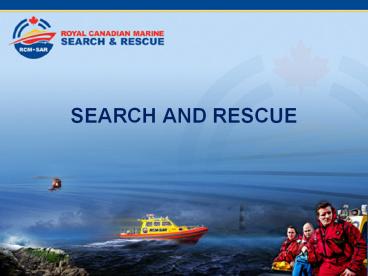SEARCH AND RESCUE PowerPoint PPT Presentation
Title: SEARCH AND RESCUE
1
SEARCH AND RESCUE
2
Joint Rescue Co-ordination Centre
- Awareness and Initial Actions
3
National SAR System
4
(No Transcript)
5
Victoria Search and Rescue Region and Adjoining
Search and Rescue Regions
6
(No Transcript)
7
JRCC Controller Duties and Responsibilities
- Requests for assistance can come from anywhere,
similar to 911 - Investigate, evaluate and consider the facts and
circumstances to determine a course of action to
resolve the incident - Detect and dispatch, matching the tasking at hand
to a suitable and available resource
8
Incident Classification
- Marine Incident
- Original vehicle operates on water
- Air incident
- Involves manned aircraft regardless of where
aircraft came to rest - Humanitarian
- Medivacs, missing persons, civilian assistance,
enforcement
9
Joint Rescue Co-ordination Centre
- Communications
10
Getting the Call
- Telephone, Pager, Radio
- JRCC
- 1-800-567-5111
- MCTS
- VHF 16, 16
- 911
11
Getting the info
- Checklists
- Initial tasking information
12
Stages of an Incident
13
(No Transcript)
14
Joint Rescue Co-ordination Centre
- Resources
15
(No Transcript)
16
SAR Vessel Capabilities
- All SAR marine resources must be capable of
- Incident detection search capability
- Survivor Recovery
- Firefighting
- Towing
- Salvage damage control
- To what extent they can carry out these tasks is
a function of their size and crew training.
17
SAR Vessel Characteristics
- Type 600/1050 - Narwhal, John Tully
- Large SAR cutter/high endurance
- All weather patrol
- Offshore operations
18
(No Transcript)
19
SAR Vessel Characteristics
- Type 500 - Gordon Reid, Tanu
- Intermediate SAR cutter/medium endurance
- Moderate weather patrol
- Close offshore operations
20
CG Gordon Reid
21
(No Transcript)
22
SAR Vessel Characteristics
- Type 400 - Arrow Post, Pt. Henry
- Small Cutter/station mode
- Medium range/moderate speed
- Semi sheltered waters operations
23
CG Cutter Point Race
24
SAR Vessel Characteristics
Hovercraft
25
Air Cushion Vehicle
26
Air Cushion Vehicle
27
47 foot Lifeboat
28
753 Rigid Hull Inflatable
29
Cormorant Helicopter
30
Buffalo Aircraft
31
Aurora Maritime Patrol Aircraft
32
Sea King with Canadian Frigates
33
Personnel
34
Royal Canadian MarineSearch Rescue
35
Joint Rescue Co-ordination Centre
- Search Planning and Operations
36
(No Transcript)
37
Creeping Line SearchUsed when search object is
more likelyto be at one end of search area than
the other
TS
38
Parallel Track SearchUsed when search object
could be anywhere in search area
?
TS
39
Sector SearchUsed when there is a high
likelihood that search objectis at datum.
each turn is 120 degrees
1 TS
Datum
2 TS
Search Unit passes repeatedly through datum.
40
Expanding Square SearchUsed when there is a high
likelihood that search objectis at datum.
Datum
- Align search legs
- with cardinal points
- Carry two DMBs
41
Barrier SearchUsed in areas of rapid current,
usually a river or confined space.
Current
- Pick landmarks to
- steer on.
- SRU must be angled to
- stem current
- OSC usually takes this search
- if its a multi-unit search
- Main search areas upcurrent
Search Area
42
Shoreline SearchA favourite for RHIs
Boulder Beach
Sandy Beach
?
?
Driftwood/Log Beach
- SRU must stay within beam sighting
- distance of beach.
- All possibilities must be investigated.
- Safety of walking Search Units
?
?
43
Joint Rescue Co-ordination Centre
- Rescue Planning and Operations
44
(No Transcript)
45
What is Risk Management?
- A process by which we can maintain an acceptable
level of safety during the operation - Safety
- The identification and control of risk
- Risk Management
- The identification and control of risk, according
to a set of preconceived parameters
46
Stop Stop outside of the event zone (100 feet in
most marine situations). Assess Everybody
observes, being careful to only discuss their
observations and not plans. Plan Everybody gets
input on the plan but the leader has the last
say. The leader assigns tasks and clarifies each
team members role. When everyone acknowledges
the plan, the team can approach.
47
Mission Analysis
- organize team to meet mission objectives
- allocate resources to critical tasks
- monitor teams and environment, and adjust
resources as necessary
48
Mission Analysis
- define tasks
- verify data
- discuss objectives
- assess risk safety risks, evaluate loss
potential - assemble plan
- critique plan
49
Severity
- The potential loss from unplanned events
- Injury, occupational illness or death
- Equipment damage
- Mission degradation
- Reduced moral
- Adverse publicity
- Administrative and/or disciplinary actions
50
Operational Risk Assessment

